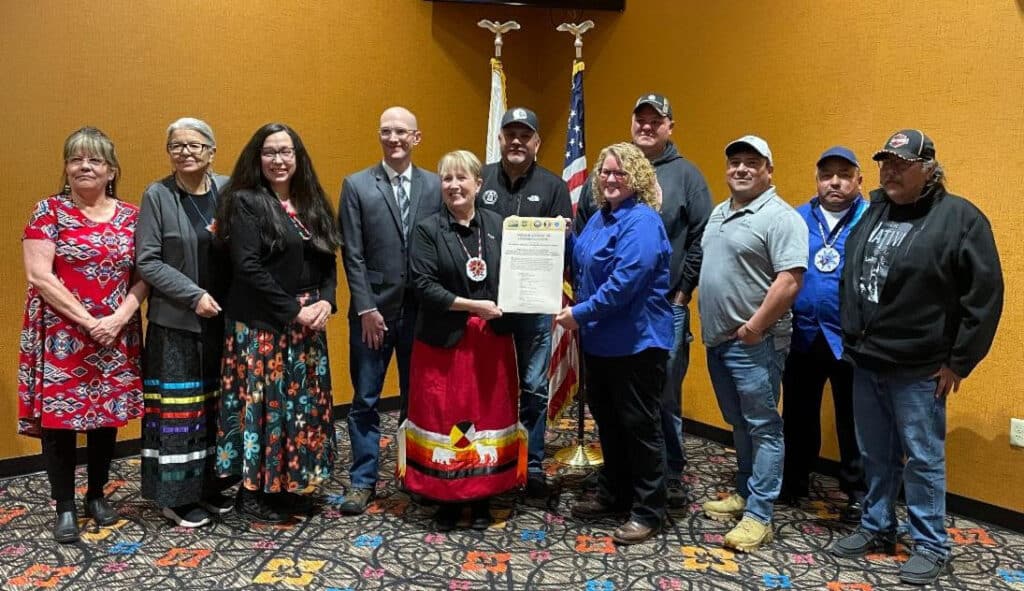
Three Ojibwe Bands with long connections and legal rights to the lands and waters of northern Minnesota have entered into an agreement with the U.S. Forest Service to work together to manage the Superior National Forest. The memorandum of understanding signed this week is the first of its kind for the 112-year-old National Forest, coming as part of a Biden administration initiative launched in 2021 which has resulted in at least 20 similar agreements around the country.
The three tribes are the Bois Forte Band of Chippewa, Fond du Lac Band of Lake Superior Chippewa, and Grand Portage Band of Lake Superior Chippewa. All three were part of an 1854 treaty with the U.S. government that guaranteed their perpetual rights to hunt, fish, and gather in the region. The Superior National Forest comprises half of the 6.2 million acres of northeastern Minnesota land where the Bands have treaty rights. Robert Deschampe, Chairman of the Grand Portage Band of Lake Superior Chippewa, noted that only 20 percent of the lands guaranteed by treaty are actually open for tribal use today.
Close collaboration
In a joint statement, the Bands and the Forest Service said the agency will ensure “meaningful and early” consultation with the tribes on activities that could affect rights reserved in the 1854 treaty.
“The MOU recognizes the Bands as original stewards of lands now encompassing the Superior National Forest and outlines procedures to ensure that Tribal input is meaningfully incorporated into Forest Service decision-making,” the memorandum says.
The agreement also calls for designation and protection of culturally-sensitive areas, coordinating forest management goals, and pursuing funding for conservation projects together. The Bands will also provide Tribal traditional ecological knowledge to the Forest Service to support conservation efforts.
“It’s historic with three Bands within the 1854 Treaty area coming together as one,” said Cathy Chavers, Chairwoman of the Bois Forte Band of Chippewa. “We, as Tribal Leaders, are charged with caring for our natural resources. This includes our elders and youth. We also must think of the next seven generations by building partnerships and strengthening relationships to work together to achieve that common goal. Chi Miigwech— we are very thankful to everyone involved in finalizing the MOU.”
Already active
Several forest management issues in the past few years have affected tribal treaty rights. Pollution from mining on public land has contaminated water and manoomin, or wild rice, as new proposals to extract copper and nickel have been debated. Lutsen Mountains’ proposal to double its skiable acres on the North Shore has raised concerns about destruction of forests important to local Indigenous people.
The tribes have also been essential to many management efforts, including studies of moose and other wildlife, contributing traditional ecological knowledge, and more.
Forest Service officials celebrated the agreement as a new philosophy of partnership with mutual benefits.
“We will walk shoulder to shoulder to integrate meaningful and deep place-based Tribal knowledge as part of what we do every day to be able to look back and be proud of what we’ve achieved together,” said Gina Owens, Regional Forester, USDA Forest Service Eastern Region.
More information:
- Co-stewardship Memorandum of Understanding agreement signed between the Bois Forte Band of Chippewa, Fond du Lac Band of Lake Superior Chippewa, Grand Portage Band of Lake Superior Chippewa, and the Superior National Forest
- FACT SHEET: Biden-Harris Administration Announces New Actions to Support Indian Country and Native Communities Ahead of the Administration’s Second Tribal Nations Summit –

